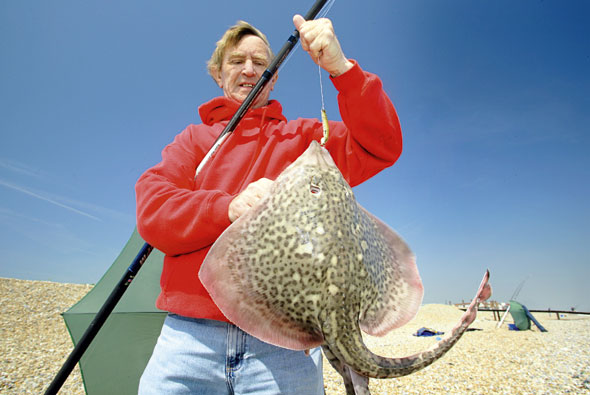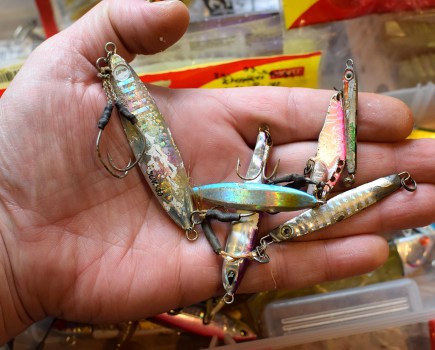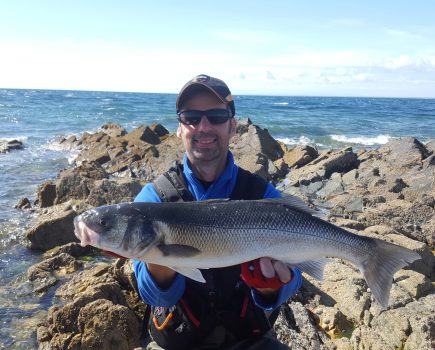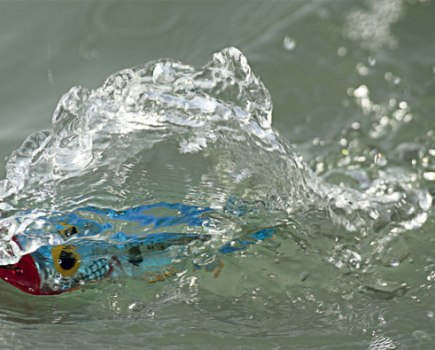Rays are thriving because commercial fishermen do not want them. This not only means stocks are increasing, but fish are getting bigger, too. Learn how to catch your share of the spring run with our easy-to-follow guide
If you are an unattractive table fish then you grow and survive. That’s pretty much what has happened to the ray family and dogfish. They don’t command big prices in the shops, so they have thrived ,and all sea anglers have cashed in on this fishing bonanza.
Add to that the fact that both are found in a similar habitat, enjoy an abundance of food, maybe at the cost of the prime species, and boat and shore anglers return most rays they catch, and you can understand the reason for the population explosion.
The two major ray species of spring are the thornback, which is the most prolific countrywide, and the small-eyed (sometimes also called the painted), which is more limited to the English Channel and Irish Sea coasts.
There are a few other rays that tend to appear from the shore occasionally, but they are mostly considered boat rays. These are the undulate, the cuckoo and the blonde, which is the biggest and the most prevalent of the less common rays.
In Kent the thornback ray has made a dramatic return to the shoreline. What this has done is allow anglers to land one of the bigger species from the shore during the less productive months between the end of the winter and the start of summer.
Big fish from the shore are scarce, and it is not easy for most anglers to catch a fish over 5lb.
The appearance of rays has changed things and this, along with captures of smoothhounds, bass and a few other summer biggies, has changed the face of sea fishing. There are those that claim spring and summer are now more attractive for shore fishing than the winter, when cod are often the only big species around.
For the last three years from spring through summer the thornbacks have expanded their size and range, and now anglers in Kent can target a ray deliberately. Kent is not the only place where the rays are showing in increasing numbers. Wales, the South West and the Bristol Channel have always been ray strongholds, but now even the North East, the Mersey estuary and the North West are producing thornback rays.
A pulley rig is perfect because the lead is lifted off the sea bed as the line is pulled through the pulley bead until it stops at the swivel. This brings the lead up to the swivel and it travels off the bottom ahead of the fish.
A single hook mono paternoster is also very effective from less snaggy venues. Anglers following this series should note that both the pulley and the paternoster are the perfect rigs for smoothhounds. In both cases a bait clip device will boost your casting distance.
The single hook snood on the mono paternoster can be fixed using crimps, stop knots or rubber bait float stops which, after the snood is fixed, can be moved easily by moving the stops.
In general snood lengths of 30in-plus are preferred for ray fishing.
RAY RIGS Why a paternoster system is best
In most cases rays are caught well out past the surf line. Rarely are they found under your feet except from a few deep water rock marks where they feed close to the kelp line.
In general you need to cast more than 100 yards, often further. There is one rig that is particularly favoured for catching rays, and that’s the pulley rig. This is a single hook rig that mixes the principles of a flowing trace with a mono paternoster. It is considered ideal for catching big fish at maximum range, and is particularly efficient at avoiding snags.
From many ray marks, such as those in South Wales and western Ireland, the bait has to be cast out past inshore rocks and ridges and any hooked fish is retrieved over the same ground.

HOOKS, CLIPS AND STOPS Simple tricks for making aerodynamic traces
The hook set up for both the pulley and the mono paternoster can be a single hook or a two-hook Pennell.
In many cases ray and smoothhound anglers who wish to return their catch use one hook, but the Pennell rig with two hooks does allow larger baits to be presented so that they stay intact.
There are several ways to make the two-hook set up on a Pennell rig. You can just slide the top hook on the snood line and then wrap the line around it to secure it in the bait.
Alternatives include a short length of rubber tubing threaded on the line to hold the sliding hook in place, while a Pennell clip actually allows you to change the hook at any time.
If you chose to use a single hook clipped-down paternoster then include a Gemini tensioning spring, known as an SRT, underneath the swivel.
This keeps the bait clipped up during the cast and is especially effective when using large baits and for casting in a buffeting wind.
Abait stop is also advised if a single hook is used. It prevents the bait blowing up the snood away from the hook during the cast.
Various options to clip the hook bait behind the lead weight on both rigs are available.
The Breakaway Impact lead is the most fail-safe. Others include the Gemini lead link with integral bait clip, the Breakaway Impact shield and the Breakaway Imp.
RAY FACT BOX
Seven things you need to know
■ Grabbing a ray by the nose is the typical way of holding it up for a picture. However, while the thornback is covered in large spines, most of the others are covered in razor-sharp sandpaper-like mini spines . So beware, because they can take the skin off your fingers. K
■ The British shore record for the thornback ray (Raja clavata) of 21lb 12oz is likely to be broken soon because lots of anglers return rays and they are being allowed to grow bigger.
■ Rays are not flatfish – they are in fact closely related to the sharks.
■ The commercial name for the thornback rays in the South and East is roker. It is also commonly called skate, but the skate (Raja batis) is a separate species and much larger.
■ Female rays grow bigger than the males.
■ Breeding age for a thornback ray is around seven years old for males and as much as nine years for females.
■ The name ‘painted ray’ is also given to the undulate ray in some areas, which causes confusion.
ALWAYS USE THE BEST BAIT There are several major choices for thornback rays
■ Frozen sandeels: A frontline ray bait that works all around the UK and Ireland is an Ammo frozen sandeel (red packet). Make sure it is the Ammo brand because few frozen sandeels stay as hard as these, with many of the inferior eels bursting their bellies and going soft once thawed. A few turns of light elastic bait cotton can be used to secure your bait.
■ Peeler crabs: The second-best bait for rays is a peeler crab. Rays of all kinds do become preoccupied with crabs when they are peeling, especially in many of our river estuaries.
■ Mackerel: A fresh mackerel is particularly good in high summer when these fish are plentiful. It is also THE ray bait in Ireland.
■ Prawns: A local choice in some estuaries for thornback rays, with Salcombe one place where it is favoured for large fish.
■ Calamari squid: Often seen as the best ray bait, although it may only catch more rays than anything else because it’s the most used, being easy to obtain. It is the perfect bait size for rays and can be used in a cocktail sausage with a crab and some mackerel.
■ Fresh herring: Highly rated by boat anglers in early spring before the crabs peel.
HOW A RAY FEEDS Bites are positive
Rays often fall on the bait and smother it. Having an under-slung mouth, this can produce lots of rod tip movement but lots of missed fish because of premature strikes.
Wait until the fish moves off after taking the bait. Bites are positive and can pull a rod in, so secure it or set the drag so the spool is released on the ratchet if a ray pulls line tight.
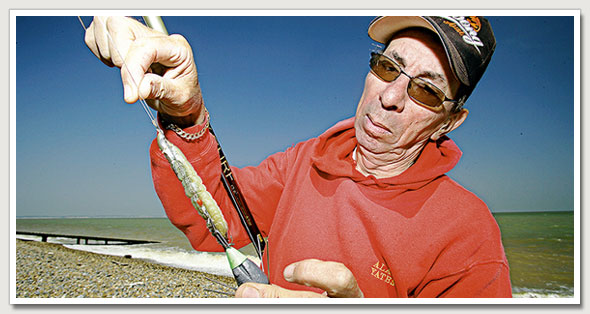
LOCATE AND CATCH Your key to success
Catching rays is mostly about locating them, because they are a shoal species. A bit like buffalo, they graze in numbers and are very vulnerable to being picked off easily.
Find one ray from a shore mark and there will undoubtedly be others. Often it is a matter of finding the precise time the species moves through on the tide.
If you are a beginner, don’t think that all you have to do is fish ray tackle and bait to catch. Choice of venue is the first step and in most cases the productive ray marks are well known.
Rays feed during day or night with the first glimmer of dawn the red-hot time on many venues, with darkness the most consistent on others. Like many large species they do take advantage of conditions, with a calming onshore sea sometimes hot in daylight and a very calm clear sea best at night.

